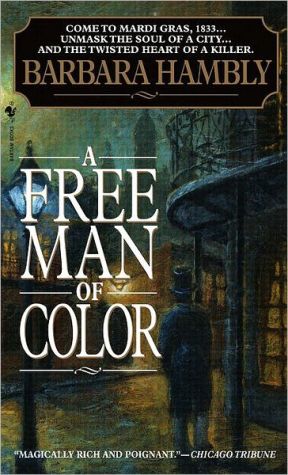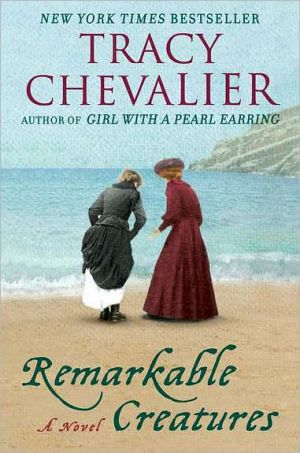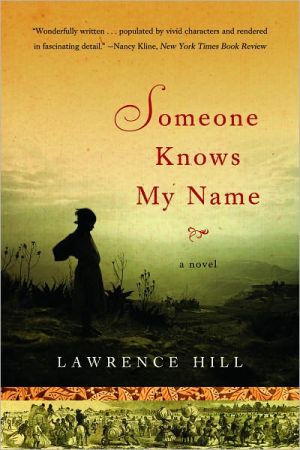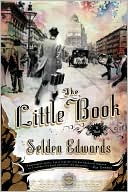A Free Man of Color (Benjamin January Series #1)
A lush and haunting novel of a city steeped in decadent pleasures...and of a man, proud and defiant, caught in a web of murder and betrayal.\ It is 1833. In the midst of Mardi Gras, Benjamin January, a Creole physician and music teacher, is playing piano at the Salle d'Orleans when the evenings festivities are interrupted—by murder.\ Ravishing Angelique Crozat, a notorious octoroon who travels in the city's finest company, has been strangled to death. With the authorities reluctant to become...
Search in google:
Benjamin January has lately returned to New Orleans from Paris, where he's made his home for the last 16 years. In Paris, January was a surgeon; in New Orleans, his life is constrained by a rigid set of rules that control his every move. He is known as a "free man of color," but in 1833, that freedom is tenuous at best. January has found a position playing piano at the Salle d'Orleans, where the Blue Ribbon Ball of this year's Carnival caps the season's revelry. The Blue Ribbon Ball, in New Orleans's strict caste system, is the quadroon ball, where the light-skinned, beautiful daughters of colored society dance with their white "protectors" -- while their protectors' wives and families are at the subscription ball in the Théâtre next door. From the safety of his piano bench, January is able to watch and comment upon the goings-on. But that detachment doesn't last. The most beautiful -- and the most poisonous -- belle of the ball, the infamous Angelique Crozat, has infuriated everyone present, from the young suitor whose stutter she has publicly mocked, to the girls whose dresses she has purposefully made somewhat less than beautiful -- including the widow of her late protector, who has violated every caste rule in order to confront her. When Angelique is discovered, in a parlor of the Salle, strangled to death, January becomes embroiled in a pursuit of the killer -- only to discover that the authorities are investigating him. Now he must run for his life, and find the culprit before he is caught and enslaved -- or hung. Mystery Magazine Online - J. Ashley...Hambly puts together a fine story and creates fascinating three-dimensional characters....This novel is less a traditional "whodunit" and more of a historical novel in which a murder occurs....Benjamin January is a wonderful addition to mystery sleuths, and this novel contributes greatly to historical fiction. The characters, setting, plot, weave together to produce a satisfying and thought-provoking read.
The ochre stucco cottage on Rue Burgundy was silent when January reached it. It was one of a row of four. He listened for a moment at the closed shutters of each of its two front rooms, then edged his way down the muddy slot between the closely set walls of the houses to the yard, where he had to turn sideways and duck to enter the gate. The shutters there were closed as well. The yard boasted a privy, a brick kitchen, and a garçonnière above it.\ When first he had lived there, his sister had occupied the rear bedroom, his mother the front, the two parlors—one behind the other—being used for the entertainment of St.-Denis Janvier. Although he was only nine years old, Benjamin had slept from the first in the garçonnière, waiting until the house lights were put out and then climbing down the rickety twist of the outside stair to run with Olympe and Will Pavegeau and Nic Gignac on their midnight adventures. He smiled, recalling the white glint of Olympe's eyes as she dared them to follow her to the cemetery, or to the slave dances out on Bayou St. John.\ His younger sister—his full sister—had been a skinny girl then, like a black spider in a raggedy blue-and-red skirt and a calico blouse a slave woman would have scorned to wear. Having a back room with access to the yard hadmade it easy for her to slip out, though he suspected that if she'd been locked in a dungeon, Olympe would still have managed to get free.\ Olympe had been fifteen the year of Dominique's birth. The two girls had shared that rear chamber for only a year. Then Dominique had occupied it alone, a luxury for a little girl growing up. But then, Dominique had always been her mother's princess, her father's pride.\ Presumably Dominique had occupied the room until Henri Viellard had come into her life when she was sixteen. By that time St.-Denis Janvier was dead, leaving his mistress comfortably off, and Livia Janvier had married a cabinetmaker, Christophe Levesque, who had died a few years ago. The rear room that had been Olympe's, then Dominique's, had been for a short spell Levesque's workshop. Now it was shut up, though Minou was of the opinion that her mother should take a lover.\ January stepped to the long opening and drew back one leaf of the green shutters, listening at the slats of the jalousie for his mother's soft, even breath.\ He heard nothing. Quietly, he lifted the latch, pushed the jalousie inward. The room was empty, ghostly with dust. He crossed to the door of his mother's bedroom, which stood half-slid back into its socket. Slatted light leaked through the louvers of the doors to the street. The gaily patterned coverlet was thrown back in a snowstorm of clean white sheets. Two butter-colored cats—Les Mesdames—dozed, paws tucked, on the end of the bed, opening their golden eyes only long enough to give him the sort of gaze high-bred Creole ladies generally reserved for drunken keelboat men sleeping in their own vomit in the gutters of the Rue Bourbon. There was water in the washbowl and a robe of heavy green chintz lay draped over the cane-bottomed chair. The smell of coffee hung in the air, a few hours old.\ Euphrasie Dreuze, or one of her friends, he thought. They had come to her for comfort, and Livia Janvier Levesque had gone.\ January crossed the yard again, his black leather music satchel under one arm. There was still fire in the kitchen stove, banked but emitting warmth. The big enamel coffeepot at the back contained several cups' worth. He poured himself some and carried it up the twisting steps and drank it as he changed his clothes and ate the beignets and pastry he'd cadged from the ballroom tables in the course of the night. Half his gleanings he'd left at Hannibal's narrow attic, stowed under a tin pot to keep the rats out of it, though he suspected the minute he was gone one or another of the girls who worked cribs in the building would steal it, as they stole Hannibal's medicine, his laudanum, and every cent he ever had in his pockets.\ Before eating he knelt on the floor beside his bed and took from his pocket the rosary he'd had from his childhood—cheap blue glass beads, a crucifix of cut steel—and told over the swift decades of prayers for the soul of Angelique Crozat. She had been, by his own experience and that of everyone he'd talked to, a thoroughly detestable woman, but only God could know and judge. Wherever she was, she had died unconfessed and would need the prayers. They were little enough to give.\
\ J. Ashley...Hambly puts together a fine story and creates fascinating three-dimensional characters....This novel is less a traditional "whodunit" and more of a historical novel in which a murder occurs....Benjamin January is a wonderful addition to mystery sleuths, and this novel contributes greatly to historical fiction. The characters, setting, plot, weave together to produce a satisfying and thought-provoking read. \ —Mystery Magazine Online\ \ \ \ \ Publishers Weekly - Publisher's Weekly\ In her breakout from fantasy and Star Wars novels, Hambly (Mother of Winter) chronicles the adventures of piano teacher and surgeon Ben January, a free man of color. The setting, 1833 New Orleans, is vivid and ornate. Riverboat dandies and roughshod frontiermen rub elbows with dueling gentlemen of the landed aristocracy as their splendidly gowned wives and colored mistresses celebrate Mardi Gras, oblivious to the squalor, fever and plague around them. Social and sexual mores are lax. Racial bigotry is the norm in a society that classifies people according to an elaborate scale of color and bloodline (octoroon, quadroon, musterfino, etc.). The plot is a whodunit involving the murder of Angelique Crozat, a beautiful but grasping octoroon who was the ex-mistress of a recently deceased Creole (white) planter. Back home after 16 years in Paris, January intervenes on behalf of Madeleine Dubonnet, a former piano student recently widowed by Arnaud Trepagier, the murdered woman's former patron. For his trouble, the ebony-skinned January becomes an unwitting scapegoat of the influential white suspects. Menaced by ruthless cutthroats, he must risk his freedom to absolve himself. Hambly pays rich attention to period detailfashion, food, manners, music and voodoo. Her characters, however, speak and think with decidedly modern accents, a departure from period verisimilitude that's easily justified on grounds of rhythm and pace. The tale lacks some of the moral gravity implied by the title, but it works as an escapist entertainment flavored liberally with the sights, textures, sounds and tastes of a decadent city in a distant time. (June)\ \ \ VOYASet in early nineteenth-century New Orleans, this murder mystery follows Benjamin Janvier, musician and free man of color, as he seeks the murder of Angelique, mistress of the husband of a white pupil he fondly remembers. Unfortunately, his search is slow and mostly devoid of the suspense suggested by the jacket illustration. The only thing that happens quickly in this novel is the introduction of the characters: fourteen in the first chapter, sixteen more in the second. Most of them remain names. The only two who come alive, police lieutenant Abishag Shaw and Benjamin's mother Livia, are in too few scenes. Hambly, a writer of intelligence, is fascinated by this world of kept women (placées) and its refined racial distinctions. The atmosphere is rich but marred by an excess of writerly writing: "the primal ocean of her hair," "pomegranate with rage," "the long fjords of his retreating hair line." Only especially interested young readers who read well will stay with this book. Even the jacket, title, and type will have little appeal for our audience. This novel is for adults with lots of time who need a new mystery romance with an unusual twist. VOYA Codes: 2Q 2P S (Better editing or work by the author might have warranted a 3Q, For the YA with a special interest in the subject, Senior High-defined as grades 10 to 12).\ \ \ \ \ Library JournalWith this historical novel, Hambly departs from her usual work in the sf/fantasy genre (e.g., Traveling with the Dead, LJ 8/95). Her new work is set in 19th-century Louisiana Creole society, where it was customary for a man to have a wife and also to keep a mistress in her own house. Benjamin January, a free Creole with dark brown skin, has returned to this society after living in Paris for more than a decade. He is trained as a surgeon, but in Louisiana, he makes his living playing the piano. Soon he is the main suspect in the death of a wealthy man's young mistress, found murdered at a ball. January spends the rest of the book gathering evidence in his defense with the help of his sisters and a host of other colorful characters he encounters on the run. The result is a complicated mystery that could have used more romantic involvement. Recommended for larger libraries.Shirley Coleman, Ann Arbor Dist. Lib., Mich.\ \ \ \ \ Kirkus ReviewsOnce again exercising her talent for goldstained description, Hambly moves from a stylish fin de siècle tale of Continental vampirism (Traveling with the Dead, 1995) to an equally stylish romantic suspenser set in New Orleans.\ The author focuses on the delicate, twilit world of color in New Orleans in the 1830s, striving to capture both the city's exotic strangeness and an absolute sense of physical reality. Despite rapt storytelling, though, Hambly's prose shows less care than her research, being replete with tired phrases ("crimson with rage," etc.). After 16 years abroad, widower Benjamin January, a very dark Creole, returns from Paris having earned his degree as a physician and, for Carnival, takes up playing piano in the band for the Blue Ribbon Ball at the Salle d'Orleans. This is the ball at which white gentlemen meet their mistresses of various skin shades, having parked their wives at the nearby Théâtre d'Orleans. When Benjamin spots a former piano student, the virtuous, newly widowed, pure white Madame Madeleine Trepagier (née Dubonnet), at the wrong ball, he tries to save her from disgrace. She's there to recover her family jewels from the city's worst, most malicious woman of color, Angelique Crozat, mistress of the late Armand Trepagier. But Angelique is strangled, robbed, and stuffed into a closet before Madeleine can talk with her. The murder investigation plunges us into the tangled nature of race relations in New Orleans, made even more complex by the fact that the free colored folk there now have to deal with the recently arrived imperial Americans, who don't recognize (as the French, the founders of the city, did) a colored entitlement to civil rights. What does it mean that the dead Angelique was wearing Madeleine's own handsewn white dress when she died?\ A sharp portrait of curiously nuanced class divisions transforms Hambly's latest into something far more than the modest melodrama it might otherwise have been.\ \ \








